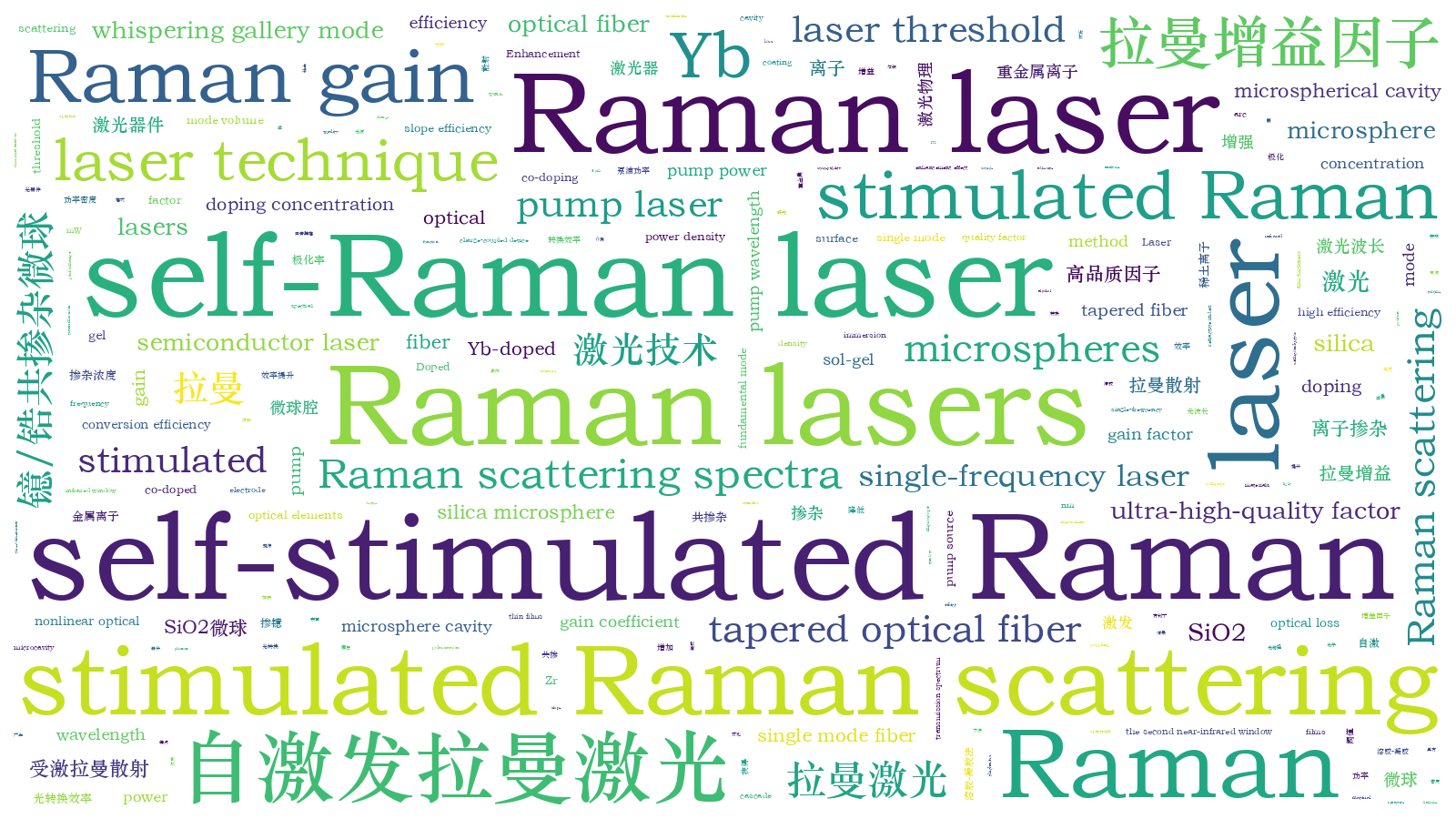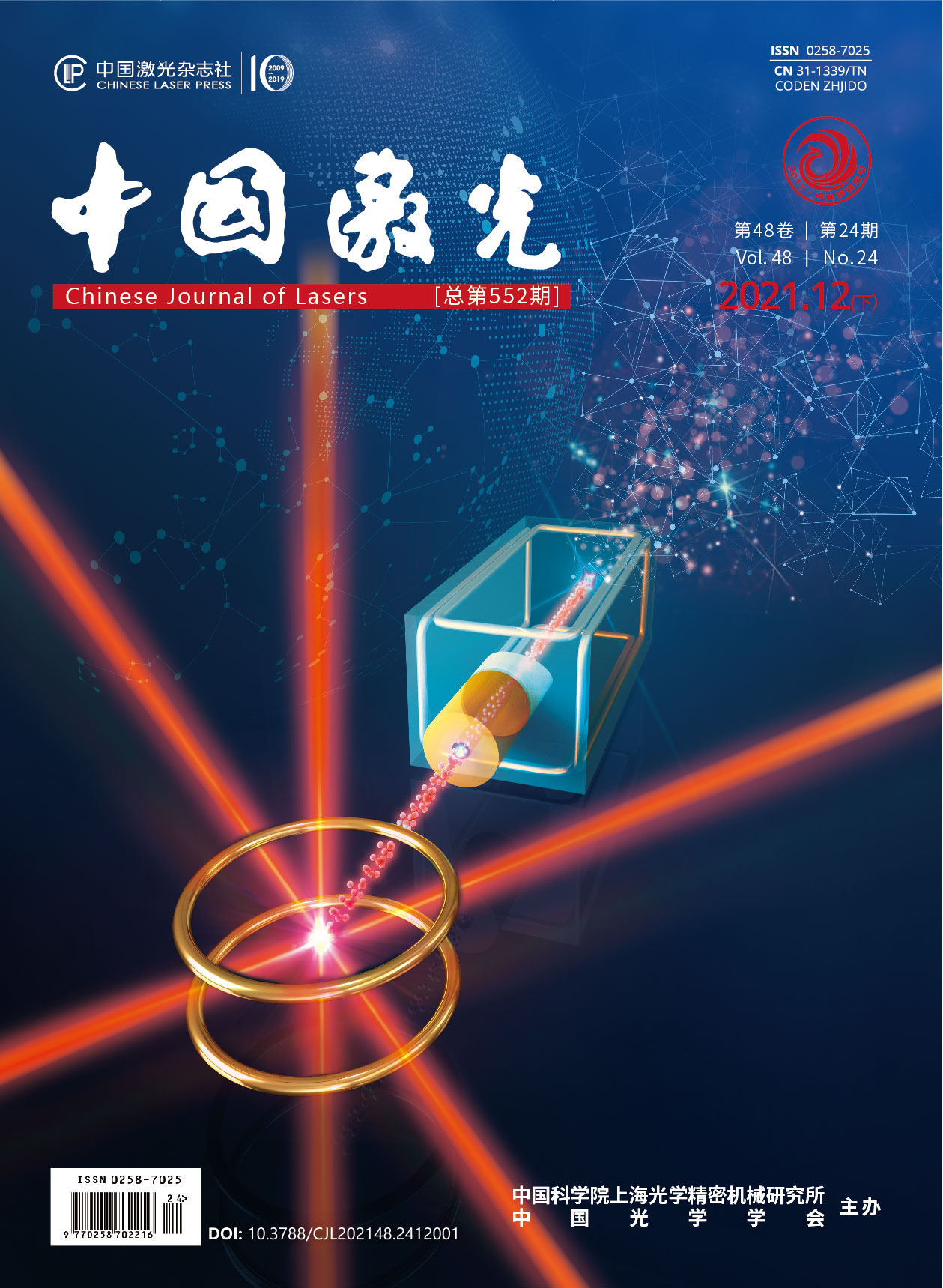锆离子掺杂对掺镱SiO2微球自激拉曼激光的增强  下载: 774次
下载: 774次
Objective Stimulated Raman scattering is an important method to extend the wavelength of the laser. The self-stimulated Raman laser is a phenomenon of the pump wavelength to excite the ions of the rare-earth-doped laser gain media and generate the fundamental mode, single-frequency laser, which then generates the stimulated Raman scattering laser. The self-stimulated Raman laser reduces the optical elements in the cavity, yielding a compact laser to reduce the optical loss, and improve the performance and efficiency of the laser. Due to the high-quality factor (Q, up to 10 9) of the whispering gallery mode (WGM), the silica microcavity has been widely used in the study of nonlinear optical phenomena. The first-order self-Raman laser for Nd 3+ doped SiO2 microspheres with high Q-value has been reported. To enhance the self-Raman laser, the silica microspheres were coated with Yb 3+-Zr 4+ doped silica film using the sol-gel and immersion method. The 976 nm pump laser was coupled with a tapered optical fiber to form a highpower density WGM in the inner surface of the microspheres. The results provide a reference for the preparation of materials with a high efficiency self-stimulated Raman laser, allowing the laser to operate at 1.2--1.3 μm wavelength band which can be used in the second near-infrared window.
Methods After removing the coating layer of the standard single mode fiber, the single mode fiber was heated using an alcohol lamp to form the tapered fiber. The end of the tapered fiber was fused with the electrode discharge arc and formed into SiO2 microspheres with handles for operation. The Yb 3+Zr 4+ doped silica was prepared by the sol-gel method with the Yb 3+ concentration of 4%, and the doping concentrations of Zr 4+ were 0%, 5%, 10%, and 15%. The optimal doping concentration of Zr 4+ was 10%. The sol-gel film was deposited on the surface of SiO2 microspheres via the immersion-lifting method. After drying, the film was melted using the electrode discharge arc to improve the Q-value of the coated microspheres. A 976 nm semiconductor laser was used as the pump source. Next, the pump light was coupled into the inner surface of the microsphere equator to form WGM by the tapered optical fiber. The coupling position between the tapered optical fiber and the microsphere was controlled by a three-dimensional adjusting frame and monitored by a charge-coupled device microscope. The output end of the tapered fiber was connected to an optical spectral analyzer (OSA, 600--1700 nm) to measure the transmission spectrum of the microspheres (Fig. 1). The basic frequency laser and self-Raman laser of Yb 3+-doped and Yb 3+-Zr 4+ co-doped microspheres were measured using this setup by gradually increasing the pump power.
Results and Discussions The Yb 3+-doped microsphere and Yb 3+-Zr 4+ co-doped microsphere have the same diameter of 68 μm with the function film thickness of 0.5 μm. Under the 976 nm excited laser with the power of 18.5 dBm, the self-stimulated Raman scattering spectra can be observed. Three orders of the cascade self-stimulated Raman laser were obtained; the wavelength of the third-order self-Raman laser can reach up to 1295 nm (Fig. 4).Alternatively, the Yb 3+-doped microsphere obtained three cascade self-Raman lasers with the pump power of 24.3 dBm, which verified that Zr doping can enhance the self-stimulated Raman laser. Thus, the laser conversion efficiency and the threshold of the third-order self-Raman laser can be achieved (Fig. 6). The 10% doping concentration of Zr 4+ makes the third-order self-Raman laser threshold only 12% of the Yb-doped microsphere, and the conversion efficiency is 3.09 times of Yb 3+-doped, which attributes to the improvement of the high polarization of the silica bond by Zr 4+ doping, thereby increasing the phonon vibration and Raman gain coefficient of the silica. According to the results, the Raman gain coefficient of the microsphere material with and without Zr 4+doping is estimated and then compared; the results show that the Yb 3+ 4% mol/Zr 4+ 10% mol doped silica increases the Raman gain factor by 18.966 times compared to the Yb 3+4% mol doped silica.
Conclusions In this study, the phenomenon of the self-stimulated Raman laser enhancement is investigated using a high Q-value microsphere cavity coupled with a tapered optical fiber. The SiO2 microspheres were coated with Yb 3+ or Yb 3+/Zr 4+ doped SiO2 thin films via the sol-gel adhesive coating method. Theoretical analysis shows that the Zr 4+ ion doped films can increase the susceptibility of the rare-earth-doped gain media and increase the Raman gain factor as well as increase the film’s refractive index to result in gathering WGMs, thereby reducing the mode volume and increasing the power density of the WGM. Both effects can reduce the Raman laser threshold and improve the efficiency of the self-stimulated Raman laser. When compared with the Yb 3+-doped silica microsphere, the experimental results show that the silica microsphere with co-doping concentration of 4% mol Yb 3+/10 mol% Zr 4+increases the Raman gain coefficient by 19 times, the slope efficiency of the third-order self-stimulated Raman laser increases by 3.09 times, and the third-order self-stimulated wavelength extends to 1295 nm. The enhancement effect of the self-stimulated Raman laser of the Yb 3+ /Zr 4+ co-doped silica microspheres is consistent with the theoretical analysis.
黄衍堂, 林晟, 刘锦萍, 许灿华, 廖廷俤. 锆离子掺杂对掺镱SiO2微球自激拉曼激光的增强[J]. 中国激光, 2021, 48(24): 2401001. Yantang Huang, Sheng Lin, Jingping Liu, Canxua Xu, Tingdi Liao. Self-Stimulated Raman Laser Enhancement of Yb 3+-Zr 4+ Co-Doped Microspheres[J]. Chinese Journal of Lasers, 2021, 48(24): 2401001.







